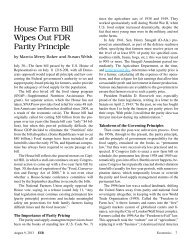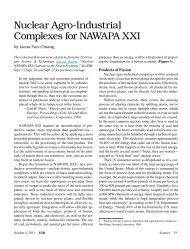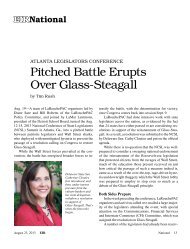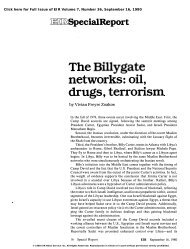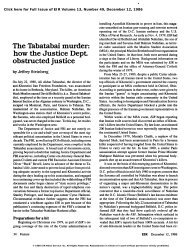Mexico's Drought Demands 'NAWAPA-Plus' Infrastructure Projects
Mexico's Drought Demands 'NAWAPA-Plus' Infrastructure Projects
Mexico's Drought Demands 'NAWAPA-Plus' Infrastructure Projects
Create successful ePaper yourself
Turn your PDF publications into a flip-book with our unique Google optimized e-Paper software.
<strong>Drought</strong> in Sonora and elsewhere in<br />
Mexico is devastating livestock and<br />
crops. Below, wheat under drought<br />
stress near Ciudad Obregón, Jan. 26,<br />
2013.<br />
North American water project.<br />
LaRouche and his associates have elaborated this<br />
project in great detail over a period of years (see following<br />
article). Complemented inside Mexico with other<br />
major infrastructure projects, including the construction<br />
of dozens of nuclear plants for electricity generation<br />
and desalination, PLHINO and PLHIGON would<br />
transport water from Mexico’s south to the waterstarved<br />
north, and through the hookup with NAWAPA,<br />
transform these parched lands into areas capable of producing<br />
bountiful quantities of food.<br />
These projects are not unknown to some of Mexico’s<br />
elected leaders. In fact, in a July 27, 2012 press<br />
conference, the same Governor Herrera who described<br />
Mexico’s current crisis in such stark terms threw down<br />
the gauntlet to then-President-elect Peña Nieto and,<br />
without naming it, called for building the PLHIGON.<br />
“We have to bring water from [the southern states<br />
of] Chiapas and Tabasco,” he said, “where, unfortunately,<br />
a large number of cubic meters of water are<br />
wasted because of its abundance, to the states of the<br />
center-north. . . . If these droughts are recurrent, we have<br />
to think of a solution that goes to the root of the problem.<br />
. . . These are long-term projects, but it will be a<br />
challenge facing the new federal government and the<br />
new Chamber of Deputies, to carry out studies and<br />
make investments. . . . We have to get going; although<br />
they are long-term projects, they can be the solution.<br />
Their cost is nothing compared to the lack of water and<br />
the dramatic consequences.”<br />
Herrera explained at that time that his proposal was<br />
Creative Commons/U. Kumar/CIMMYT<br />
to build “aqueducts, which would help to fundamentally<br />
mitigate the grave problem of drought which the<br />
region is suffering, and which is leaving millions of<br />
people defenseless.” He added that this project would<br />
be a “bridge” to unite Mexico’s regions, and bring<br />
greater economic growth, employment, and welfare to<br />
families, and that five regional meetings would be held<br />
in different states during August.<br />
During the May 29 gathering, Congressman Oscar<br />
Cantón Zetina of the southeastern state of Tabasco offered<br />
his state’s water supply for the nation’s development,<br />
given that Tabasco possesses 30% of Mexico’s<br />
surface water and experiences annual floods. If we<br />
build pipelines for gas, oil, and their derivatives, he<br />
asked, why can’t we do the same for water? We must<br />
invest in transporting the water and making it potable,<br />
he said. Tabasco can provide much of this water to the<br />
entire nation.<br />
In March of this year, Energy Minister Joaquín<br />
June 14, 2013 EIR Economics 35





